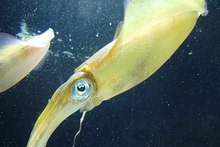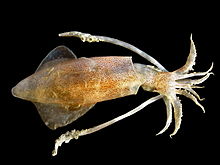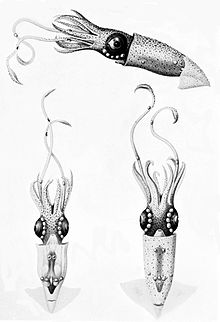Squids
| Squids | ||||||||||
|---|---|---|---|---|---|---|---|---|---|---|

Squid |
||||||||||
| Systematics | ||||||||||
|
||||||||||
| Scientific name | ||||||||||
| Teuthida | ||||||||||
| Naef , 1916 |
The zoological order of the squid (Teuthida) represents the largest group within today's cephalopods with more than 250 species . Together with the real cuttlefish (Sepiida), the dwarf squid (Sepiolida) and the post squirrel ( Spirula spirula ), which alone is a separate group Spirulida represents, the squids form the group of ten-armed squids (Decabrachia).
The name Kalmar is medieval Latin Calamari "squid" in Latin calamus returned "tube", which probably refers to the tube-like arms.
features
The mantle is usually wedge-shaped and is held in shape by a flat gladius made of a chitinous substance that functions as an endoskeleton . The beak is made of horn . The shape resembles a parrot's beak , an example of an analog organ .
There are ten tentacles around the mouth, eight of which are rather short and completely covered with suction cups . Two tentacles are slimmer, strongly elongated and have a widening at the ends, which is occupied with suction cups. This enables squids to catch their prey (fish, crabs and other mollusks). These arms are also known as tentacles . The shorter arms are used to bring the prey to the mouth, where it is mainly crushed with the beak and radula .
The eyes are significantly larger in relation to the body than in other groups. After building their eyes, the squids are divided into two groups. The closing-eye squids (Myopsida) with the Loligo species have eyelids with which they can close their eyes, while most naked-eye squids (Oegopsida) cannot close their eyes.
Many squids are capable of changing colors, and the species of the deep sea in particular have various luminous organs that they can use to distract their enemies and to attract prey.
Way of life
Squids are adapted to life in the open water ( pelagic ) of the seas. In this they differ, for example of the genuine squid ( cuttlefish ), who live near the ground.
Locomotion
The squids move through a funnel from which they press water out of the mantle cavity. This way they can reach very high speeds. Some species manage to fly a short distance close to the water surface with this drive technology and thus even save energy over long distances. Flight distances of up to 50 meters and an altitude of up to six meters above the surface of the water are occupied. The muscles on the sipho allow you to change the direction of the water jet and thus maneuver very quickly. The smaller species in particular swim in large schools.
nutrition
Using a study carried out in 2015, researchers at the GEOMAR Helmholtz Center were able to draw conclusions about food intake and the associated locations of oceanic squids. As part of this investigation, 129 specimens of the species Sthenoteuthis pteropus were caught in order to examine their stomach contents and to analyze the stable isotope ratios in the muscle tissue and in the gladius . The studies showed that ocean squids have a very broad spectrum of food choices. In addition to being fed by shellfish and fish, some of them also show cannibalistic behavior.
pairing
Squids usually mate in large flocks, which in some species can take on considerable proportions. After mating , in which the male pushes a spermatophore into the female's coat to fertilize the eggs, the eggs are deposited in long gelatinous tubes on stones and plants.
Squids and people
Squid accidents
Large squids, especially the Humboldt squid , can also be dangerous for humans in swarms. A few fatal attacks by the animals have been documented.
An accident that went off lightly for the people involved is known from 1873. Two fishermen believed a giant squid floating off the coast of Newfoundland to be a wreck and rowed a small boat out to examine it. When they tried to pull their boat up to the supposed wreck with grappling hooks, the squid struggled and bit a piece from the side of the rowing boat. The fishermen cut off one of the animal's tentacles about 6 meters long and left. In the literature it is assumed that the squid was driven to the surface while dying and that the grappling hook mobilized it for the last time.
A fatal accident occurred during the Second World War . The German auxiliary cruiser Thor sank the British troop carrier Britannia . After the sinking, eleven survivors clung to a life raft, one of which, according to the rest of the group, had been pulled down by a large cephalopod.
Human nutrition
Especially in European and North African Mediterranean regions, squids are part of the human diet and are caught and marketed for this purpose.
Systematics of squids
The following list contains the overwhelming number of squid species, individual species and group portraits can be found on the pages created for this purpose. However, German names only exist for a fraction of the squid species. The classification of the giant squids ( Architeuthis spec.) And the magic lamp ( Lycoteuthis spec.) In the squids is still being discussed, but they are included in this list.
literature
- Richard Ellis: Giant Octopus of the Deep Sea. HEEL-Verlag, Königswinter 2002, ISBN 3-89365-876-9 .
- Kir Nazimovich Nesis: Cephalopods of the World - squids, cuttlefishes, octopuses, and allies. TFH Publ, Neptune City, NJ, 1987, ISBN 0-86622-051-8 .
- Mark Norman: Cephalopods A World Guide. ConchBooks, Hackenheim 2000, ISBN 3-925919-32-5 .
Web links
Individual evidence
- ↑ Norman, 2000, p. 131.
- ↑ See Kalmar at Duden online.
- ↑ Squid can fly to save energy on nature.com, accessed February 22, 2012
- ↑ Ron O'Dor: The incredible flying squid. In: New Scientist No. 2865 of May 19, 2012, pp. 39-41, doi: 10.1016 / S0262-4079 (12) 61301-3
- ↑ Squids: Underrated Actors in the Ocean. December 21, 2017. Retrieved December 29, 2017 .
- ↑ Roland Hanewald: The tropics book. Jens Peters Publ., Berlin 1987, ISBN 3-923821-13-1 , p. 188.
- ^ Loligo vulgaris (Lamarck, 1798). on the website of the Food and Agriculture Organization of the United Nations.






